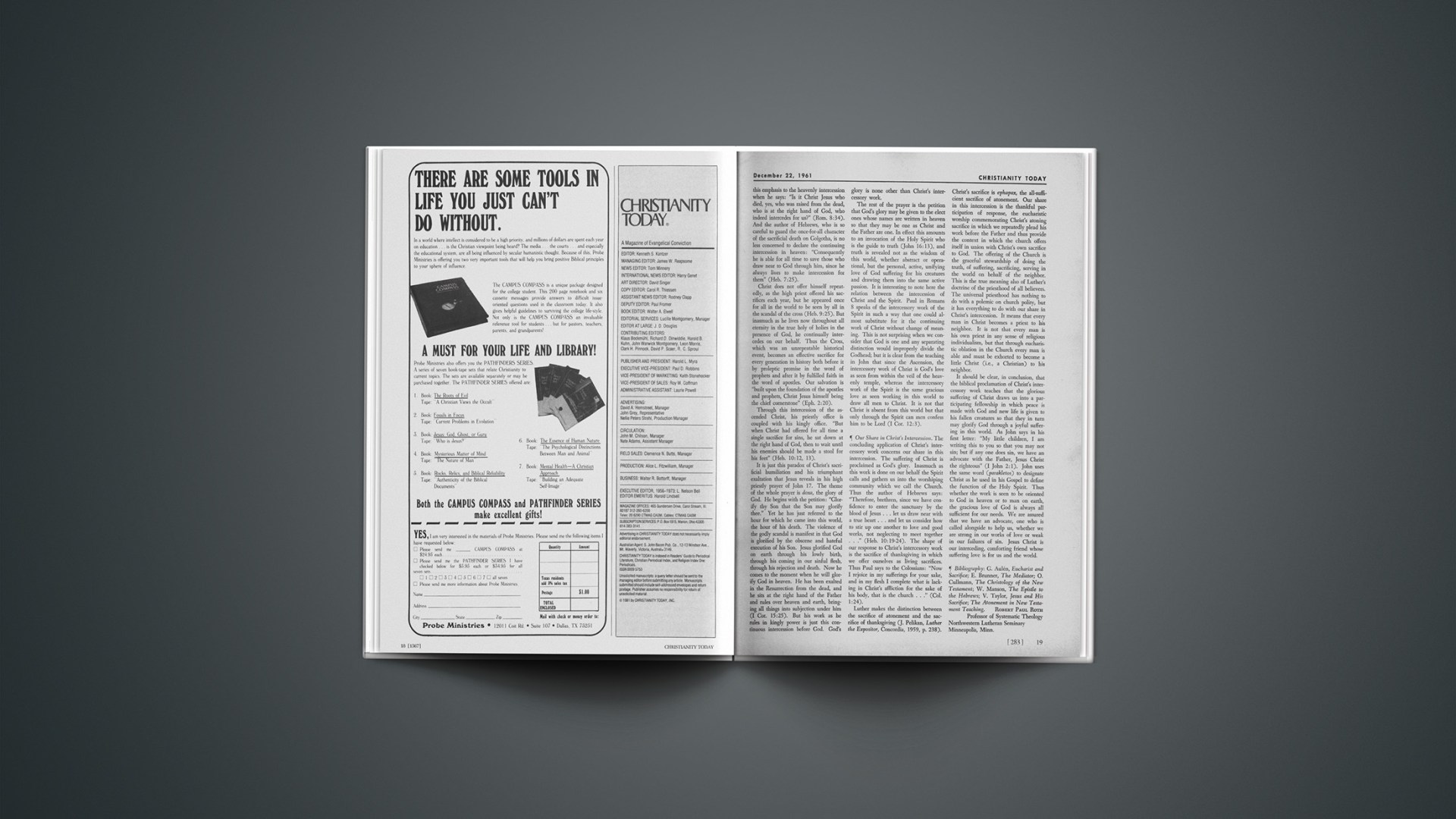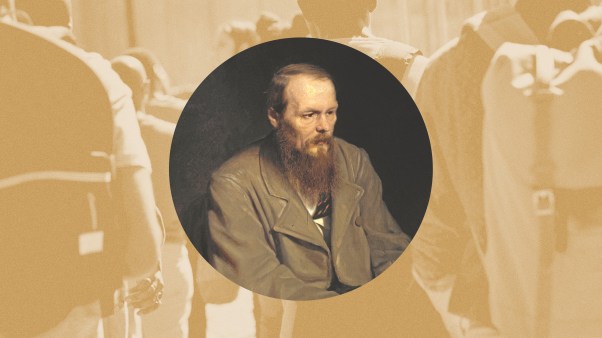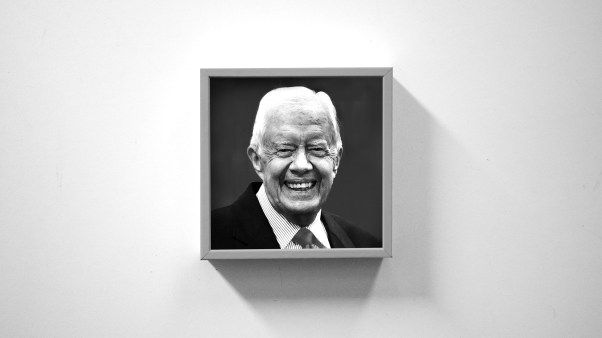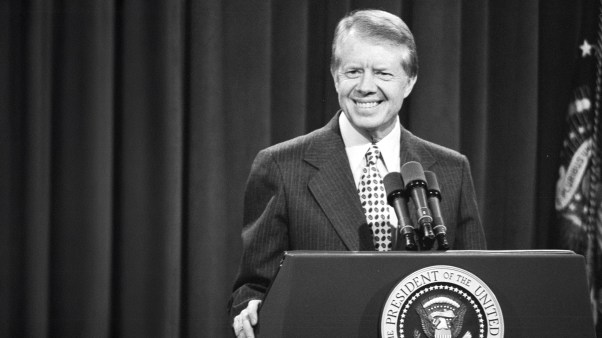The intercessory work of Christ presupposes that the predicament of man is not an alleged flaw in his existence but the enmity which separates the creature from the Creator. “For if while we were enemies we were reconciled to God by the death of his Son, much more, now that we are reconciled, shall we be saved by his life” (Rom. 5:10). Furthermore, just as no mere analysis of human existence in psychological or philosophical categories will provide an adequate anthropology, so likewise no definition of Christ in terms of substance or nature will properly describe his intercessory action. Much modern Protestant theology, however, exhibits such a protest against the merely physical conception of the Lord’s state in heaven that the reality of Christ’s work has been volatilized into a gaseous vacuity. A true biblical understanding will appreciate the power of Christ’s personal pleading as God’s Word in action, God in Jesus giving his life at the right time for the ungodly.
Old Testament Priestly Sacrifice. The concept of intercession has its roots in the priestly sacrifice of the Old Testament. God was at work in the family of Israel providing sacrifices which were acceptable for atonement before the once-for-all sacrifice of Jesus. Aaron was instructed to come once a year to the holy place with a bull, a ram, and a goat, sacrificing them with the laying on of hands and sprinkling the blood of the bull and the goat on the mercy seat and offering the ram as a burnt offering (Lev. 16:5–19). A second goat was driven into the wilderness with the laying on of hands and the confession of the sins of the people (Lev. 16:20–22). This system of sacrifices hearkened back to the experience of Abraham in which God provided a ram as a substitute for Isaac, and it projected forward to Christ in the anticipation of the Suffering Servant of Isaiah on whom was laid the iniquity of us all (Gen. 22:8; Isa. 53:6).
The significant thrust throughout the history of sacrifice is therefore the intercession of God in providing the sacrifice from the ram of Abraham to Jesus, the lamb of God, who was also caught on the branches of a tree. Precisely here is the difference between the biblical understanding of sacrifice on the one hand and both pagan and perverted Jewish notions on the other. In pagan sacrifice a gift is offered by man in hope of gaining favor from the god. Thus man works a change upon the god through his offering. In the practice of Judaism a work is done by man in the hope of changing the heart of man, cleansing him so as to render him acceptable to God. But the Christian revelation in both testaments teaches that God intercedes providing a sacrifice which changes the wrath of God into mercy and the sinner into a saint.
Sören Kierkegaard’s references in Fear and Trembling to the sacrifices of Iphigenia, Jephthah’s daughter, and Abraham’s son serve well to illustrate these three conceptions of sacrifice (Oxford, 1943, pp. 127 ff.). Agamemnon and Jephthah make their sacrifices for a reason: Agamemnon vows to offer his daughter to gain a favorable wind; Jephthah vows to provide a thank offering of whoever comes to meet him from his door after he has defeated the Ammonites. Abraham has no reason that might be justified ethically. He simply prepares to sacrifice Isaac in obedience to the Lord. What was done by Agamemnon was a supreme human effort to control the gods; what was done by Jephthah was a valiant human attempt to preserve the integrity of the heart. Abraham alone accepted the intercessory work of God by offering whatever God provided whether it be his only beloved son or a ram caught in a bush.
Christ’s Reconciling Sacrifice. When, according to the history of salvation, the right time (kata kairon) had come, God’s Messiah interceded by means of his sacrifice in order to reconcile helpless and rebellious sinners with the Father (Rom. 5:6). Thus as in the Old Testament the priest represented man and offered a sacrifice to God, so now Christ Jesus as man offers himself as a “fragrant offering and sacrifice to God” (Eph. 5:2). “For our sake he [God] made him [Christ] to be sin who knew no sin, so that in him we might become the righteousness of God” (2 Cor. 5:21).
Since God in his gracious favor toward man was concerned to free us from our bondage to sin, flesh, and the power of the devil, he sent his Son “in the likeness of sinful flesh” (Rom. 8:3). “Therefore he had to be made like his brethren in every respect, so that he might become a merciful and faithful high priest in the service of God, to make expiation for the sins of the people” (Heb. 2:17). The Greek verb hilaskesthai and its substantive form to hilasterion in Romans 3:21 are both used in the Septuagint to render the propitiation offered to God at the mercy seat in the holy of holies (Exod. 25:17; 31:7; 35:12; 37:6; Lev. 16:2, 13). The meaning is that God in the person of Christ acts mercifully on behalf of sinners by sacrificing his life. This suffering, which is accepted that all righteousness may be fulfilled, is well pleasing to God because it is God’s glory that he spends himself for his creature (Matt. 3:15–17).
Intercession must be made by a mediator who can successfully represent both sides. A priest is such a mediator because he represents his own people as he offers their spotless gift which is received by the holy God. But here the ineffectualness of every human intercession is manifest: the gift is never spotless and hence it is not well pleasing to God. In Christ’s intercession a pure gift is offered since he who is sinless gives himself.
Christ’s Continuing Work. Christ’s work is not ended with his death on the cross in the sense of finis, although it is certainly complete in the sense of tetelestai, but he continues to plead for sinners in heaven. Sacrifice we found to be the basic meaning of Christ’s intercession since through it God is glorified magnificently over his enemies and his rebellious creatures are reconciled. But in the Old Testament the central moment of sacrifice was not in the slaying of the victim but in what was done with the blood when it was released. Blood was understood to mean the life of the victim. When blood was shed it signified the pouring out of the victim’s life. On the Day of Atonement the ritual sacrifice brought the priest into the holy of holies behind the veil of the temple where he sprinkled the mercy seat with the lifeblood of the sacrificial animal. Hence the moment of the ephapax of Christ’s sacrifice is not the death on Golgotha alone but also and especially the heavenly moment of presentation of his sacrifice to the Father at his ascension. Paul gives this emphasis to the heavenly intercession when he says: “Is it Christ Jesus who died, yes, who was raised from the dead, who is at the right hand of God, who indeed intercedes for us?” (Rom. 8:34). And the author of Hebrews, who is so careful to guard the once-for-all character of the sacrificial death on Golgotha, is no less concerned to declare the continuing intercession in heaven: “Consequently he is able for all time to save those who draw near to God through him, since he always lives to make intercession for them” (Heb. 7:25).
Christ does not offer himself repeatedly, as the high priest offered his sacrifices each year, but he appeared once for all in the world to be seen by all in the scandal of the cross (Heb. 9:25). But inasmuch as he lives now throughout all eternity in the true holy of holies in the presence of God, he continually intercedes on our behalf. Thus the Cross, which was an unrepeatable historical event, becomes an effective sacrifice for every generation in history both before it by proleptic promise in the word of prophets and after it by fulfilled faith in the word of apostles. Our salvation is “built upon the foundation of the apostles and prophets, Christ Jesus himself being the chief cornerstone” (Eph. 2:20).
Through this intercession of the ascended Christ, his priestly office is coupled with his kingly office. “But when Christ had offered for all time a single sacrifice for sins, he sat down at the right hand of God, then to wait until his enemies should be made a stool for his feet” (Heb. 10:12, 13).
It is just this paradox of Christ’s sacrificial humiliation and his triumphant exaltation that Jesus reveals in his high priestly prayer of John 17. The theme of the whole prayer is doxa, the glory of God. He begins with the petition: “Glorify thy Son that the Son may glorify thee.” Yet he has just referred to the hour for which he came into this world, the hour of his death. The violence of the godly scandal is manifest in that God is glorified by the obscene and hateful execution of his Son. Jesus glorified God on earth through his lowly birth, through his coming in our sinful flesh, through his rejection and death. Now he comes to the moment when he will glorify God in heaven. He has been exalted in the Resurrection from the dead, and he sits at the right hand of the Father and rules over heaven and earth, bringing all things into subjection under him (1 Cor. 15:25). But his work as he rules in kingly power is just this continuous intercession before God. God’s glory is none other than Christ’s intercessory work.
The rest of the prayer is the petition that God’s glory may be given to the elect ones whose names are written in heaven so that they may be one as Christ and the Father are one. In effect this amounts to an invocation of the Holy Spirit who is the guide to truth (John 16:13), and truth is revealed not as the wisdom of this world, whether abstract or operational, but the personal, active, unifying love of God suffering for his creatures and drawing them into the same active passion. It is interesting to note here the relation between the intercession of Christ and the Spirit. Paul in Romans 8 speaks of the intercessory work of the Spirit in such a way that one could almost substitute for it the continuing work of Christ without change of meaning. This is not surprising when we consider that God is one and any separating distinction would improperly divide the Godhead; but it is clear from the teaching in John that since the Ascension, the intercessory work of Christ is God’s love as seen from within the veil of the heavenly temple, whereas the intercessory work of the Spirit is the same gracious love as seen working in this world to draw all men to Christ. It is not that Christ is absent from this world but that only through the Spirit can men confess him to be Lord (1 Cor. 12:3).
Our Share in Christ’s Intercession. The concluding application of Christ’s intercessory work concerns our share in this intercession. The suffering of Christ is proclaimed as God’s glory. Inasmuch as this work is done on our behalf the Spirit calls and gathers us into the worshiping community which we call the Church. Thus the author of Hebrews says: “Therefore, brethren, since we have confidence to enter the sanctuary by the blood of Jesus … let us draw near with a true heart … and let us consider how to stir up one another to love and good works, not neglecting to meet together …” (Heb. 10:19–24). The shape of our response to Christ’s intercessory work is the sacrifice of thanksgiving in which we offer ourselves as living sacrifices. Thus Paul says to the Colossians: “Now I rejoice in my sufferings for your sake, and in my flesh I complete what is lacking in Christ’s affliction for the sake of his body, that is the church …” (Col. 1:24).
Luther makes the distinction between the sacrifice of atonement and the sacrifice of thanksgiving (J. Pelikan, Luther the Expositor, Concordia, 1959, p. 238). Christ’s sacrifice is ephapax, the all-sufficient sacrifice of atonement. Our share in this intercession is the thankful participation of response, the eucharistic worship commemorating Christ’s atoning sacrifice in which we repeatedly plead his work before the Father and thus provide the context in which the church offers itself in union with Christ’s own sacrifice to God. The offering of the Church is the graceful stewardship of doing the truth, of suffering, sacrificing, serving in the world on behalf of the neighbor. This is the true meaning also of Luther’s doctrine of the priesthood of all believers. The universal priesthood has nothing to do with a polemic on church polity, but it has everything to do with our share in Christ’s intercession. It means that every man in Christ becomes a priest to his neighbor. It is not that every man is his own priest in any sense of religious individualism, but that through eucharistic oblation in the Church every man is able and must be exhorted to become a little Christ (i.e., a Christian) to his neighbor.
It should be clear, in conclusion, that the biblical proclamation of Christ’s intercessory work teaches that the glorious suffering of Christ draws us into a participating fellowship in which peace is made with God and new life is given to his fallen creatures so that they in turn may glorify God through a joyful suffering in this world. As John says in his first letter: “My little children, I am writing this to you so that you may not sin; but if any one does sin, we have an advocate with the Father, Jesus Christ the righteous” (1 John 2:1). John uses the same word (parakletos) to designate Christ as he used in his Gospel to define the function of the Holy Spirit. Thus whether the work is seen to be oriented to God in heaven or to man on earth, the gracious love of God is always all sufficient for our needs. We are assured that we have an advocate, one who is called alongside to help us, whether we are strong in our works of love or weak in our failures of sin. Jesus Christ is our interceding, comforting friend whose suffering love is for us and the world.
Bibliography: G. Aulén, Eucharist and Sacrifice; E. Brunner, The Mediator; O. Cullmann, The Christology of the New Testament; W. Manson, The Epistle to the Hebrews; V. Taylor, Jesus and His Sacrifice; The Atonement in New Testament Teaching.
Professor of Systematic Theology
Northwestern Lutheran Seminary
Minneapolis, Minn.










